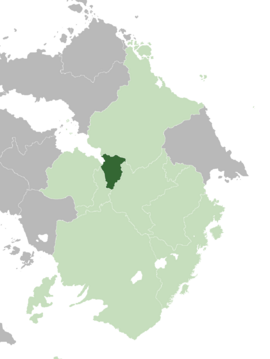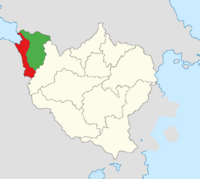Hollona and Diorisia
This article is a work-in-progress because it is incomplete and pending further input from an author. Note: The contents of this article are not considered canonical and may be inaccurate. Please comment on this article's talk page to share your input, comments and questions. |
Union State of Hollona and Diorisia | |
|---|---|
|
Flag | |
Motto: Nihil boni sine labore "Nothing achieved without hard work" | |
 Location of Hollona and Diorisia (dark green) in the Levantine Union (light green) and Levantia (gray) | |
| Capital and largest city | Mesellianum |
| Official languages | Vandarchine Rhotian |
| Demonym(s) | Holldoner or Diorisian (depending on region of origin) |
| Government | |
• Speaker-President | Ioannes Marcellino |
| State Union Council | |
| Popular Assembly | |
| Establishment | |
• Independence from HLE | 1935 |
| Population | |
• 2020 estimate | 19,958,242 |
| GDP (PPP) | estimate |
• Per capita | 39,257 |
| GDP (nominal) | estimate |
• Total | 783,496,192,704 |
| Currency | Taler (₮) |
The Union State of Hollona and Diorisia, also known by its unofficial name, the Vandarch Republic, is a country in Levantia. It is located in the extreme northwestern region of Dericania and borders the Vandarch. It is a member of the Levantine Union. Though the united republic was established during the Second Fratricide, the union of Hollona and Diorisia dates to the mid-18th century, when the former Ænglish realm territory of the Duchy of Hollona was inherited by the Elector of Diorisia, giving the much larger territory of Diorisia access to the Vandarch. The Union State is unique within Dericania as having a lasting Ænglish cultural influence, leading to the creation of a heavily Ænglicized Derian culture within the country and a national identity - the Vandarchine people - which largely views itself in contrast to the nearby Rhotians.
Etymology
Geography
History
Antiquity and prehistory
Medieval Diorisia
Union established
Fanerian domination
20th century
Establishment of the Republic
The area of present day Hollona and Diorisia was of major strategic advantage during the early phases of the Second Great War, as it was a major potential corridor of resupply of Fiannria from Urcea and Burgundie. The area also controlled the Carolina-Grand Canal, making it an important checkpoint of Vandarch access.
Early uprisings in the Derian revolutionary period of the war lead the Elector of Diorisia to abandon the principality on May 18th, 1934. Following his flight, the territory was reorganized as the Vandarch Autonomous Area of the Deric Republic, though in practice it became the domain of a loosely allied band of Derian nationalist warlords. Until the entry of Faneria into the war, the Vandarch Autonomous Area was largely an ignored theater of the war in Dericania, but with the entry of Faneria and sudden need to resupply Fiannria with Levantine goods, the area became a top priority. On April 17th, 1935, Urcea and Fiannria launched a joint campaign which culminated with the occupation of the country on April 29th, 1935. Rather than restoring the Elector, however, the allied powers reached a negotiated settlement with sympathetic local nationalist groups and established the Provisional Republic of Hollona and Diorisia, reorganizing the former separate duchies (and other Prince-Bishoprics in the area) into a single, united Republic on May 11th, 1935. Though derided by the Deric Republic as a collaborationist state, the Republic maintained its separate ethnic identity from the Derian people. The Republic subsequently claimed neutrality in the conflict but allowed allied forces and supplies to flow through the country. Upon the Republic's proclamation, it entered an intentionally ambiguous state with relationship to the Holy Levantine Empire, withdrawing from its institutional structure but not making any firm determination about its sovereign status with respect to the Republic; the proclamation stated that this ambiguity would continue "until such time when the Republic has fully considered and upon such time of a general peace". The Republic was accordingly removed entirely from its legal obligations to the Empire with the Treaty of Corcra.
Post-Great Wars
Hollona and Diorisia was a founding member of the Deric States which were established in 1953.
The MS Hollona sank on Thursday, 18 February 1993 as the ship was crossing the Vandarch Sea, en route from Carlshaven, Hollona, to Gabion, Yonderre. The disaster claimed the lives of 852 people, being one of the worst maritime disasters of the 20th century. In 1995, several wineries in Hollona and Diorisia were found to have illegally modified their wines using the chemical diethylene glycol, a toxic substance frequently found in antifreeze. The incident became an international scandal which all but destroyed wine export from Hollona and Diorisia for almost two decades.
21st century
Secession from the Deric States
On March 8 2023, Hollona and Diorisia formally informed the Levantine Union of its intention to leave the Deric States organization and become a standalone member of the Union, effective immediately. This decision triggered the first stages of the Dissolution of the Deric States.
Government

The politics and administration of Hollona and Diorisia take place in a framework of a parliamentary representative democracy, whereby executive power is exercised by the State Union Council. As a federation, it has several levels of political structuring. The most important of these levels is the division of the country into two entities: the Republic of Hollona and the Republic of Diorisia. The State Union Council, the upper chamber of the legislature, is represented by five members from each of the two Republics, and from this body the Speaker-President is elected, serving three year terms. This State Union Council serves in a limited executive capacity, voting primarily on matters of state recommended to it by the Popular Assembly. The lower chamber, the Popular Assembly, is lead by the Chair of the Assembly, and is the nation's chief legislative body, representing proportionally-allocated electoral districts.
Culture
Vandarchine identity
The nationality of people from Hollona and Diorisia is "Vandarchine", and Vandarchines consider themselves both a nation and ethnic group. Vandarchines are a relatively newer group of people, originating from Hollona and Diorisia. The 16th century Nordmontaine War and addition of the Ænglish Duchy of Hollona to the relatively equal sized Rhotian Duchy of Diorisia created a cultural interchange between these people, resulting in the creation of a distinct Vandarchine culture speaking Ænglish with many Rhotian cultural traditions. The rulers of the two Duchies were relatively open to the cultural changes the Ænglish brought, leading to a relatively early emergence of this national identity - newspapers and journals from the 1710s speak to residents of the two duchies viewing themselves as a separate and united people. As its national conciousness emerged earlier, Vandarchines never viewed themselves as part of the Derian identity, but nonetheless committed themselves to joining a united Dericanian polity at various times.
Language
Vandarchines speak a regional dialect of the Rhotian language known as Vandarchine Rhotian. It maintains the structure, intonation, and other main features of the Rhotian language but includes a significant vocabulary from the Ænglish language.